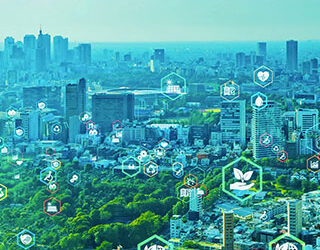Decoding Energy and Climate Change
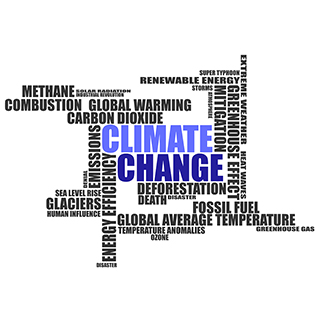
The modern green movement has taken over the world in recent years. We hear about sustainability, climate change, energy conservation, conscious consumer behaviour and choices, energy efficiency, and of course, going green! But where does all of this stem from?
Today, we are at the brink of worst climate change consequences. While these consequences have undoubtedly started to show in various forms around us already, there still lies enormous potential ahead of us all to address and mitigate this through collective climate action. Our efforts today define tomorrow’s landscape for our future generations and the green movement, as mentioned above, is how we contribute to the global climate crisis. According to the latest research from the Intergovernmental Panel on Climate Change (IPCC), we have less than 11 years to make the transformation necessary to avoid the worst impacts of climate change. The level of carbon dioxide in the atmosphere would have to be cut by 45% by 2030 to prevent global warming above 1.5oC – in other words, the threshold at which the worst impacts of climate change could be averted.
Read below as we decode energy and climate change for a cleaner and sustainable tomorrow. We will discuss the root cause of problems leading to severe climate change and understand areas where our contributions can make a huge difference!
Where does energy come from and why is it problematic?
Most of the energy that we consume is generated from fossil fuels that include coal, oil, and natural gas, which take thousands of years for formation. These sources of energy cannot be reused or renewed and are finite in nature.
Our dependence on fossil fuels to meet our energy demands has increased over many decades. Since the industrial revolution, fossil fuels have become a dominant source of energy globally. Today, 91.04% of India’s energy demand is met by fossil fuels (2019). This is how India’s trend of fossil fuel dependence looks like since 1965:
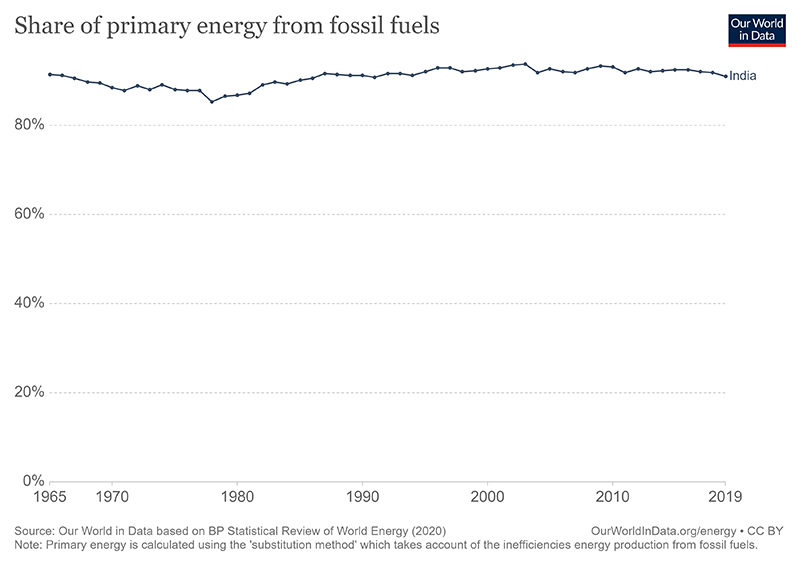
But this comes at a hidden cost! Fossil fuel burning emits huge amounts of carbon dioxide and other harmful greenhouse gases, thus becoming a huge contributor to climate change and the greenhouse effect. As of 2018, global energy-related CO2 emissions rose 1.7% to a historic high of 33.1 Gt CO2. As greenhouse gas emissions from human activities increase, they build up in the atmosphere warming the planet. Moreover, because these greenhouse gases have the potential of staying in the atmosphere for tens and hundreds of years after being released, its impact on the climate is long lasting, affecting current and future generations. In recent months, this has been seen in the form of shockingly heavy rainfall, leading to floods in Western Europe; Countries such as Belgium, Germany, Luxembourg and the Netherlands received up to two months’ rain in two days on 14-15 July. In contrast, Northern Europe struggled with the brunt of scorching heat waves. Extreme heatwaves in Western North America have been responsible for devastating extreme wildfires; California on 9 July set a world record for the hottest reliably measured temperature in Earth’s history with temperature of 54.4°C for the second time. It is also reeling under severe and exceptional droughts, the words since 800 AD. In India, heavy rainfall resulted in cloudbursts, flooding, and landslides in areas of Bihar, Himachal, and Uttarakhand.
Fossil fuel alternatives: renewable energy and energy efficiency
Renewable energy
Renewable energy is defined as energy that is collected from natural resources, i.e., sun, wind, or water. With the worrying state of affairs of global climate change, it has gained more interest and attention over the course of years.
While renewable energy sources are environment friendly, it comes with its own limitations for us to completely transition to clean energy:
- Uncertainty: the uncertainty in the production of energy through natural resources makes renewable energy an unreliable source of energy. It is uncontrollable by humans; for example, solar powered energy will only be generated in the presence of sunshine, or wind energy generation depends on the availability of wind.
- Resource location: renewable energy sources are highly dictated by location. Renewable energy plants that share their energy with the grids need large spaces for operations, in the absence of which, the cost and efficiency of the framework is disrupted. Additionally, renewable energy sources heavily rely on weather and climatic conditions, which makes it selective for integration as per the appropriateness of the region.
- Quality: uninterrupted high-power quality is needed in the case of renewable energy systems to ensure high efficiency and stability of networks. Poor power quality can have adverse effects on the grid and also lead to higher costs and equipment failure.
In India, after a steady slow pace for many years, renewables have gained momentum in the recent past. According to a study published by UK’s Carbon Tracker in collaboration with the Council on Energy, Environment and Water (CEEW), India’s demand for fossil fuel electricity fell in 2019 and 2020 significantly. From less than 20GW of solar power in 2010 it has grown to 96GW of solar, wind biomass and small hydro power in May 2021 — including large hydropower, renewables now provide 142GW or 37% of the country’s power capacity. India has effectively proven that with the right kind of policy support and intervention, its complete transition to clean energy is not far enough.
The share of non-fossil sources in India’s installed capacity of electricity has grown to 38%. Further, efforts are being made to increase the share of natural gas, which is environment friendly and less polluting, in the energy basket from the current 6% to 15% by 2030. In the past seven years, India has invested as much as USD 70 billion (about 5.2 lakh crore) in renewable energy across the country.
In order to meet its Paris Agreement targets, India has maintained that it is not a polluter and cause of climate change and has voluntarily committed to reducing greenhouse gas emission intensity of its GDP by 33-35% below 2005 levels by 2030.
Energy efficiency
Every year, significant energy is wasted through transmission and inefficient technologies, that not only is harmful for the environment but also hefty for our pockets. Energy conservation or energy efficiency simply means saving energy by using it efficiently and eliminating energy waste.
A typical household can save approximately 25% on utility bills with energy efficiency measures, which amounts to $2,200 annually. While energy efficiency is regarded as an expensive option in the short term when compared to conventional alternatives, utility bill savings over the life of the efficient product can fully offset the initial cost premium and yield an implicit return on investment for homeowners.
Understanding energy trends: a closer look at where the problem lies and also areas with the maximum potential for energy saving and efficiency interventions
It is imperative to understand the impact of the energy sector on climate change to be able to fully realise the importance of switching to clean energy.
The below given graph highlights the global energy-related carbon emissions for the period 1900-2020. It represents a consistent and a steep rise for straight two decades, calling for immediate interventions to address the same. Although, it does reflect a dip through 2020, the year of the COVID-19 pandemic that forced us all to stay indoors and put a halt to economic activities across the world. The 2020 dip in global CO2 emissions has been the lowest since 2010 and is the largest ever, six times larger than the previous record reduction of 0.4 Gt in 2009.
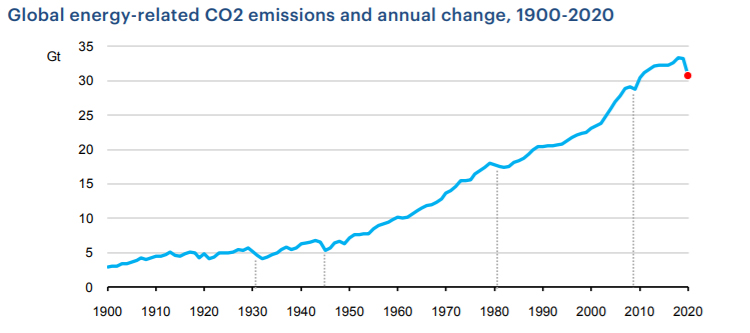 Source: Global Energy Review 2020, International Energy Agency (IEA)
Source: Global Energy Review 2020, International Energy Agency (IEA)
While this is proof of how adversely human activities have impacted the environment and contributed to climate change all these years, it also suggests that there are still ways to bring down our energy consumption.
Sector-wise carbon emissions
Global greenhouse gas emissions are driven by a range of sectors and processes. There is no single solution to reach net-zero; it has to be a combined product of energy efficient innovations among sectors, interventions at the policy level, and consumer behavioural change to further sustainable and cleaner lifestyle choices.
Below given is a break-up of greenhouse gas emissions, sector and sub-sector wise, to understand which kind of human activities contribute the most to increased global carbon footprints:
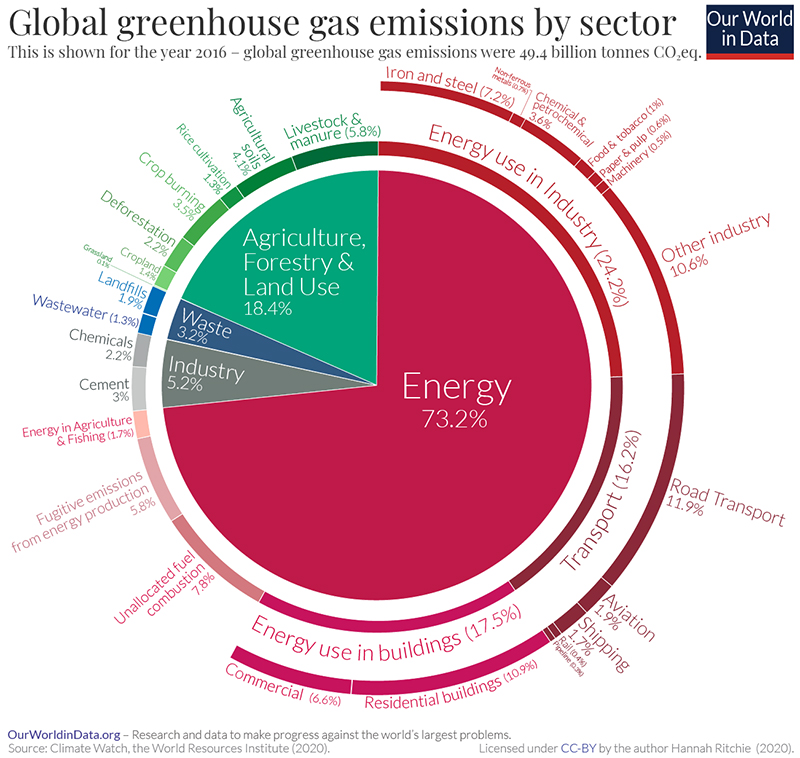 Source: Climate Watch, the World Resources Institute (2020)
Source: Climate Watch, the World Resources Institute (2020)
Potential sector-wise decarbonising solutions
Buildings
The buildings sector must decarbonise by decreasing energy intensity by at least 80% by 2030 and be climate neutral by 2050, if we are to meet the Paris Agreement Goal of keeping global warming to 1.5 degree Celsius above pre-industrial levels. Moreover, lowering carbon emissions from the building sector plays a crucial role in decarbonising the economy. Providing thermal comfort, reliable electricity, and nutritional food to people is a key challenge and also a pressing priority in many parts of the world. This offers emerging opportunities for more future-ready buildings and habitable communities- with ambitious building energy codes, net-zero carbon buildings, grid-interactive buildings, and low-energy cooling innovations in the buildings sector.
Some of the solutions to make this possible in India include:
- Mainstreaming super-efficient appliances: electricity consumption in the residential sector is projected to grow from 259 TWh in 2016-2017 (MoSPI, 2018) to 533 TWh in 2027 (CEA, 2017), putting pressure on energy supply and the environment due to increased greenhouse gas emissions. Examining the applicability of the most energy-efficient technologies for residential appliances could spur improvement in the energy performance of these appliances.
Read: https://aeee.in/wp-content/uploads/2020/07/2019-Mainstreaming-Super-efficient-Appliances-in-India.pdf - Adaptive thermal comfort (ATC):within the next decade, India’s cooling energy demand will grow 2-3 times over the current level. Of this overall nationwide cooling demand, space cooling, i.e. comfort cooling in the building sector, comprises 50% of the total; this sector also shows the maximum improvement potential in terms of energy saving and carbon emission reduction. Space cooling thus represents a key opportunity area for proactively managing India’s cooling energy demand.Adaptive thermal comfort (ATC) is recognised as a definitive means to achieving energy savings and offers a low-capital intervention opportunity to achieve savings through user adaptation.Read: https://aeee.in/wp-content/uploads/2020/07/2018-Projecting-National-Energy-Saving-Estimate-from-the-Adoption-of-High-Performance-Windows-Glazing-in-2030.pdf
Transport
The ever-escalating energy demand, coupled with concerns regarding increasing greenhouse gas (GHG) emissions from the use of Internal Combustion Engine (ICE) driven vehicles, has forced us to look for alternative energy options for mobility. This, in turn, has paved the path for electrification of road transport. Electric vehicles (EVs) are considered a cleaner mode of transport, as well as an environmentally friendly option to tackle the problem of poor air quality. Moreover, low maintenance and operating costs, as compared to ICE vehicles, are an additional benefit associated with EVs.
Read about EVs as a possible grid resource in India: https://aeee.in/wp-content/uploads/2020/10/Full-Report-Vehicle-Grid-Integration-AEEE.pdf
Industries
The industrial sector relies heavily upon the consumption of unsustainable fossil fuels such as coal, oil, and gas for its energy needs, which leads to greenhouse gas emissions causing global warming. This poses serious climate threats. Sustainable energy transition within this sector can be made possible through low carbon alternative fuels, technological innovations, demand reduction, energy efficiency, design & construction optimisation strategies, and best energy management practices. This further needs to be backed by policies and regulations, energy and carbon disclosure mechanisms, and tax reforms and incentives, to ensure fool-proof decarbonisation of the sector.
Read on possible measures to mitigate GHG emissions from the Indian cement industry: https://aeee.in/wp-content/uploads/2020/12/cement-sector-emission.pdf
Conclusion
Climate change is not a distant threat- it is happening right now, in this very moment, as you read this article. The impacts of climate change can be seen around us in many forms- extreme weather conditions, increased natural disasters, etc., and a lot of it is contributed by our own daily activities.
The transition to a green and sustainable economy has to be a collective effort. Triple sector collaboration (private sector, the government, and civil society) for this very reason needs to be made more robust for effective outcomes. There needs to be more meaningful discourse to bring awareness on the subject in order to induce behavioural change; simple energy efficient solutions in our daily lives can significantly reduce our carbon footprints, combating climate change.
Energy efficiency often plays out quietly in the background but has been effective in making huge strides in lowering GHG emissions over the years. Greater investment in energy efficiency can potentially help mitigate the impacts of climate change. Also, in the context of the Sustainable Development Goals (SDGs), the United Nations Development Programme (UNDP) argues that energy efficiency offers a unique opportunity to reconcile economic competitiveness with sustainable development, simultaneously reducing the cost of energy and increasing productivity.
At this point, it is critical to invest in long-term planning to mitigate complex scenarios that hinder the betterment of our environment. For us, climate change lies at the apex of it. Let us take to the green movement and do our bit.
This blog is written by Radhika Israni
Radhika Israni is a Communications Officer in the Communications and Marketing vertical at AEEE. Her expertise lies in digital campaigns, social media, and weaving content into meaningful and interesting narratives.
